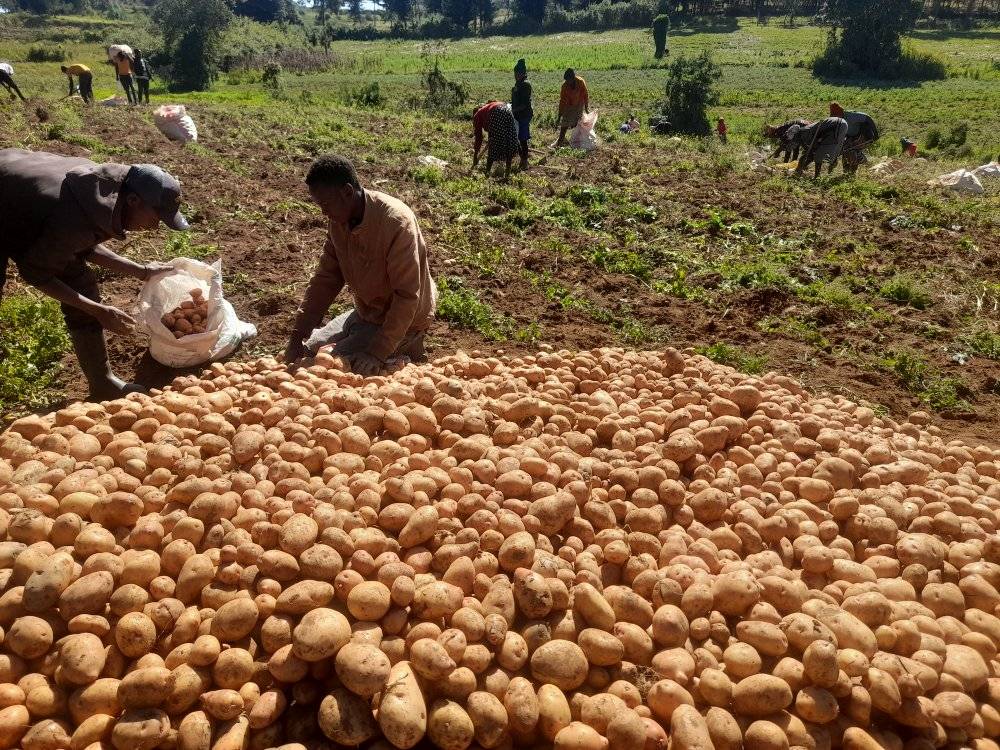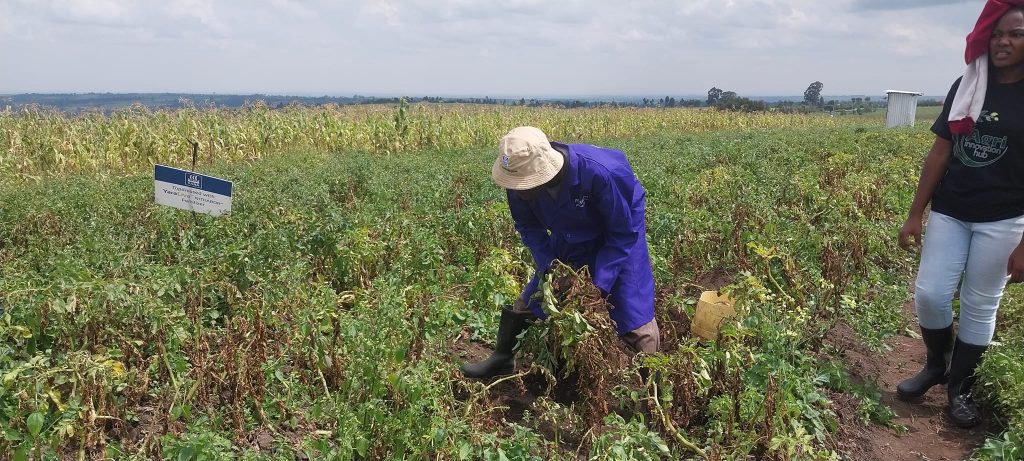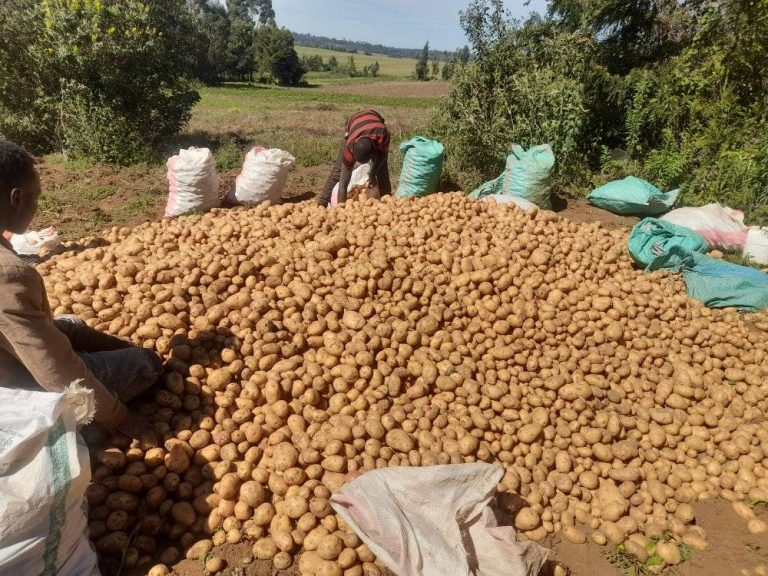How Profitable Is Potato Farming In Kenya Per Acre?
Potato farming in Kenya can be quite profitable when done correctly, but the profitability depends on various factors such as the region, farming practices, access to markets, and input costs.
Here’s an overview of the potential profitability of potato farming per acre in Kenya:
- Yield: The average potato yield in Kenya ranges from 5 to 15 tons per acre, depending on the region, variety, and farming practices. Higher yields are generally achieved in the favorable growing conditions of the central and rift valley regions.
- Production Costs: The production costs for potato farming in Kenya can vary significantly, but they typically range from KES 100,000 to KES 250,000 per acre (approximately $800 to $2,000). These costs include expenses for seeds, fertilizers, pesticides, labor, and other inputs.
- Market Prices: The market price for potatoes in Kenya fluctuates based on supply and demand dynamics. Currently, the average farm-gate price for potatoes ranges from KES 25 to KES 45 per kg (approximately $0.20 to $0.35 per kg).
- Profitability Estimates:
– For a yield of 10 tons per acre and a selling price of KES 30 per kg, the gross revenue would be KES 300,000 ($2,400).
– If the production costs are around KES 150,000 ($1,200), the net profit would be approximately KES 150,000 ($1,200) per acre.
– In optimal conditions, with yields of 15 tons per acre and higher market prices, net profits can reach up to KES 300,000 ($2,400) or more per acre.
On average, a well-managed potato farm in Kenya can produce anywhere from 50 to 150 bags of potatoes of 90kgs per acre.
It’s important to note that these figures are estimates, and actual profitability can vary significantly depending on factors such as access to markets, post-harvest handling, and the efficiency of the farming operations.

To maximize profitability, Kenyan potato farmers are encouraged to adopt best practices, such as using high-quality certified seeds, implementing integrated pest management strategies, investing in irrigation systems, and establishing strong market linkages.
Forming cooperatives or collective marketing groups can help farmers achieve economies of scale, negotiate better prices, and access resources more efficiently.
While potato farming in Kenya can be a lucrative venture, it also comes with risks and challenges, such as pest and disease outbreaks, adverse weather conditions, and market volatility.
Proper planning, risk management, and a commitment to sustainable farming practices are essential for ensuring long-term profitability and success in the industry.
Potato Farming In Kenya
Potatoes are one of the world’s most important crops, playing a crucial role in global food security and livelihoods. In Kenya, potato farming has emerged as a significant agricultural activity, contributing to both national food security and economic development.
This article delves into the world of potato farming in Kenya, exploring its history, current status, challenges, and future prospects.
Potato farming is a significant agricultural activity in Kenya and is a vital source of income for many smallholder farmers in the country. With ideal soil and climatic conditions, potato production is a thriving industry in several regions, including the highlands of Eastern Kenya.
Potatoes are grown using both conventional and organic methods, and the country has produced a surplus of potatoes in recent years, making it a major exporter in the region. In 2020, Kenya was ranked ninth in the world in potato production with over 1.2 million hectares and 5.5 million tonnes of production.
Today, potato farming is a vital agricultural activity in Kenya, with the crop cultivated in various agro-ecological zones, including highlands such as the Rift Valley, Mount Kenya region, and parts of Western Kenya.
Smallholder farmers dominate potato production, with both subsistence and commercial farming practices prevalent. The country’s diverse climatic conditions allow for year-round potato cultivation, contributing to its status as a staple food crop.
Varieties Of Potatoes In Kenya
Here are some of the well-performing potato varieties in Kenya along with their characteristics:
- Shangi:
- Description: Oval-shaped tuber with white flesh, cream skin, and medium to deep eyes.
- Growing Regions: Thrives in areas like Meru, Nakuru, Kwale, Nandi, Kisii, Nyandarua, Kiambu, Nyeri, and Taita-Taveta.
- Maturity Period: Less than three months.
- Yield: Medium.
- Usage: Table variety and for making chips.
- Manitou:
- Description: Oval or long oval-shaped tuber with red smooth skin, shallow eyes, and pale yellow flesh.
- Growing Regions: Well-suited for almost all potato-growing regions in Kenya.
- Maturity Period: 3-4 months.
- Yield: Approximately 40 tons per hectare.
- Usage: Mainly used for making fries.
- Sherehekea:
- Description: Round tubers with smooth red skin, deep eyes, and cream flesh.
- Growing Regions: Grows well in areas like Kwale, Kericho, Nandi, Nyandarua, Kiambu, Nyeri, Laikipia, and Meru.
- Maturity Period: 3-4 months.
- Yield: High yielding variety.
- Usage: Resistant to late blight and potato virus Y.
- Kenya Mpya:
- Description: Oval-shaped tuber with smooth cream skin and creamy flesh.
- Growing Regions: Thrives in most potato-growing regions in Kenya.
- Maturity Period: 3-4 months.
- Yield: Medium yield variety.
- Usage: Primarily used for making fries.
- Unica:
- Description: Oblong tubers with red skin, shallow eyes, and creamy flesh.
- Growing Regions: Suitable for both lowlands and highland regions of Kenya.
- Maturity Period: Less than 3 months.
- Yield: High yield under intensive management.
- Usage: Suitable for chips, crisps, and as a table variety rich in vitamin C.
- Dutch Robjin:
- Description: Oval-shaped tubers with yellow skin and flesh.
- Growing Regions: Suitable for highland regions like Nyandarua, Meru, and Nyeri.
- Maturity Period: 3-4 months.
- Yield: Medium to high yield.
- Usage: Ideal for boiling and making mashed potatoes.
- Tigoni:
- Description: Round to oval tubers with red skin and white flesh.
- Growing Regions: Thrives in cool highland areas like Tigoni, Limuru, and parts of Central Kenya.
- Maturity Period: 3-4 months.
- Yield: Good yield under proper management.
- Usage: Suitable for boiling, roasting, and making salads.
- Cherangani:
- Description: Oval-shaped tubers with red skin and white flesh.
- Growing Regions: Well-suited for regions with cooler climates like Cherangani Hills, Mount Elgon, and parts of Rift Valley.
- Maturity Period: 3-4 months.
- Yield: Medium to high yield.
- Usage: Versatile variety suitable for various culinary uses.
- Asante:
- Description: Oval to long oval tubers with yellow skin and flesh.
- Growing Regions: Adaptable to various regions across Kenya.
- Maturity Period: 3-4 months.
- Yield: Good yield potential.
- Usage: Ideal for boiling, baking, and making French fries.
- Nyayo:
- Description: Oval-shaped tubers with red skin and white flesh.
- Growing Regions: Suitable for regions with moderate temperatures like parts of Central Kenya and Rift Valley.
- Maturity Period: 3-4 months.
- Yield: Medium yield variety.
- Usage: Preferred for boiling, roasting, and making stews.
Challenges Facing Potato Farmers:
Despite its importance, potato farming in Kenya is not without its fair share of challenges. One of the most pressing issues is the prevalence of pests and diseases, which can wreak havoc on crop yields and quality.
Early and Late blight, a devastating fungal disease, is a constant threat, capable of wiping out entire fields if not properly managed.

Other pests, such as potato tuber moths and potato cyst nematodes, can also cause significant damage, requiring constant vigilance and the implementation of integrated pest management strategies.
Access to high-quality seed potatoes is another major obstacle for Kenyan farmers. Many smallholders rely on recycled seeds, which can lead to lower yields and increased susceptibility to diseases.
Establishing a robust seed potato production and distribution system is crucial for improving productivity and ensuring the long-term sustainability of the industry.
Amidst these challenges lies a wealth of opportunities. The growing demand for potatoes, both domestically and in regional markets, offers significant potential for farmers to increase their incomes and improve their livelihoods.
Again, the adoption of modern farming techniques, such as precision agriculture and the use of drought-resistant varieties, can help mitigate the impacts of climate change and enhance overall productivity.
Strengthening Value Chains and Market Linkages
While increasing production is essential, ensuring efficient and equitable value chains is equally crucial for the success of potato farming in Kenya.
Strengthening market linkages between farmers, processors, and consumers can minimize post-harvest losses, improve distribution channels, and create new opportunities for value addition.
The establishment of potato collection centers and cold storage facilities in major production hubs can significantly reduce spoilage and enable farmers to fetch better prices for their crops.
Furthermore, the development of processing facilities for products like potato chips, French fries, and starch can generate additional revenue streams and create employment opportunities in rural areas.

